Root Litter Mixing with That of Japanese Cedar Altered CO2 Emissions from Moso Bamboo Forest Soil
Abstract
1. Introduction
2. Materials and Methods
2.1. Study Sites and Focal Species
2.2. Experimental Design and Soil CO2 Emission Measurement
2.3. Litter and Soil C and N Measurement
2.4. Data Analyses
3. Results
3.1. Soil CO2 Emission Rates as Affected by N and Litter Treatment
3.2. Correlations between Soil CO2 Emission Rates and Soil Temperature and Moisture
4. Discussion
4.1. Changes in Soil CO2 Emission Rates as Affected by N and Litter Treatments
4.2. Correlations between Soil CO2 Emission Rates and Soil Temperature
5. Conclusions
Author Contributions
Funding
Acknowledgments
Conflicts of Interest
References
- SakİN, E.; Aise, D.; Sakin, E.D.; Ece, T. Carbon Stocks in Harran Plain Soils, Sanliurfa, Turkey. Not. Bot. Horti Agrobot. Cluj-Napoca 2010, 38, 151–156. [Google Scholar]
- Jenkinson, D.S.; Adams, D.E.; Wild, A. Model estimates of CO2 emissions from soil in response to global warming. Nature 1991, 351, 304–306. [Google Scholar] [CrossRef]
- Zak, D.R.; Pregitzer, K.S.; King, J.S.; Holmes, W.E. Elevated atmospheric CO2, fine roots and the response of soil microorganisms: A review and hypothesis. New Phytol. 2000, 147, 201–222. [Google Scholar] [CrossRef]
- Carbonell-Bojollo, R.M.; de Torres, R.-R.M.A.; Rodríguez-Lizana, A.; Ordóñez-Fernández, R. Influence of Soil and Climate Conditions on CO2 Emissions from Agricultural Soils. Water Air Soil Poll. 2012, 223, 3425–3435. [Google Scholar] [CrossRef]
- Bengtson, P.; Falkengren-Grerup, U.; Bengtsson, G. Relieving substrate limitation-soil moisture and temperature determine gross N transformation rates. Oikos 2005, 111, 81–90. [Google Scholar] [CrossRef]
- Billings, S.; Ballantyne, F. How interactions between microbial resource demands, soil organic matter stoichiometry, and substrate reactivity determine the direction and magnitude of soil respiratory responses to warming. Glob. Change Biol. 2013, 19, 90–102. [Google Scholar] [CrossRef]
- Chen, Y.; Sun, J.; Xie, F.; Yan, Y.; Xiaodan, W.; Cheng, G.; Lu, X. Non-additive effects of litter diversity on greenhouse gas emissions from alpine steppe soil in Northern Tibet. Sci. Rep. 2015, 5, 17664. [Google Scholar] [CrossRef]
- Berger, T.W.; Inselsbacher, E.; Zechmeister-Boltenstern, S. Carbon dioxide emissions of soils under pure and mixed stands of beech and spruce, affected by decomposing foliage litter mixtures. Soil Biol. Biochem. 2010, 42, 986–997. [Google Scholar] [CrossRef]
- Zech, W.; Senesi, N.; Guggenberger, G.; Kaiser, K.; Lehmann, J.; Miano, T.M.; Miltner, A.; Schroth, G. Factors controlling humification and mineralization of soil organic matter in the tropics. Geoderma 1997, 79, 117–161. [Google Scholar] [CrossRef]
- van der Valk, A.G.; Attiwill, P.M. Above- and Below-Ground Litter Decomposition in an Australian Salt Marsh. Aust. J. Ecol. 1983, 8, 441–447. [Google Scholar] [CrossRef]
- Martinez-Yrizar, A.; Núñez, S.; Burquez, A. Leaf litter decomposition in a southern Sonoran Desert ecosystem, northwestern Mexico: Effects of habitat and litter quality. Acta Oecol. 2007, 32, 291–300. [Google Scholar] [CrossRef]
- Zhang, L.; Zou, J.; Siemann, E. Interactive effects of elevated CO2 and nitrogen deposition accelerate litter decomposition cycles of invasive tree (Triadica sebifera). For. Ecol. Manag. 2017, 385, 189–197. [Google Scholar] [CrossRef]
- Zhang, L.; Zhang, Y.; Zou, J.; Siemann, E. Decomposition of Phragmites australis litter retarded by invasive Solidago canadensis in mixtures: An antagonistic non-additive effect. Sci. Rep. 2014, 4, 5488. [Google Scholar] [CrossRef] [PubMed]
- Liu, X.; Siemann, E.; Cui, C.; Liu, Y.; Guo, X.; Zhang, L. Moso bamboo (Phyllostachys edulis) invasion effects on litter, soil and microbial PLFA characteristics depend on sites and invaded forests. Plant Soil 2019, 438, 85–99. [Google Scholar] [CrossRef]
- Deng, B.; Fang, H.; Jiang, N.; Feng, W.; Luo, L.; Wang, J.; Wang, H.; Hu, D.; Guo, X.; Zhang, L. Biochar Is Comparable to Dicyandiamide in the Mitigation of Nitrous Oxide Emissions from Camellia oleifera Abel. Fields. Forests 2019, 10, 1076. [Google Scholar] [CrossRef]
- Zhang, L.; Ma, X.; Wang, H.; Liu, S.; Siemann, E.; Zou, J. Soil Respiration and Litter Decomposition Increased Following Perennial Forb Invasion into an Annual Grassland. Pedosphere 2016, 26, 567–576. [Google Scholar] [CrossRef]
- Zhang, L.; Wang, H.; Zou, J.; Rogers, W.E.; Siemann, E. Non-Native Plant Litter Enhances Soil Carbon Dioxide Emissions in an Invaded Annual Grassland. PLoS ONE 2014, 9, e92301. [Google Scholar] [CrossRef]
- Lu, R.K. Soil and Agro-Chemical Analytical Methods; China Agricultural Science and Technology Press: Beijing, China, 1999; Volume 107, pp. 146–195. (In Chinese) [Google Scholar]
- Corre, M.; Veldkamp, E.; Arnold, J.; Wright, S.J. Impact of elevated N input on soil N cycling and losses in lowland and montane forests in Panama. Ecology. 2010, 91, 1715–1729. [Google Scholar] [CrossRef]
- Hobbie, S.E. Interactions between Litter Lignin and Nitrogenitter Lignin and Soil Nitrogen Availability during Leaf Litter Decomposition in a Hawaiian Montane Forest. Ecosystems 2000, 3, 484–494. [Google Scholar] [CrossRef]
- Li, L.-J.; Zeng, D.-H.; Yu, Z.-Y.; Fan, Z.-P.; Yang, D.; Liu, Y.-X. Impact of Litter Quality and Soil Nutrient Availability on Leaf Decomposition Rate in a Semi-Arid Grassland of Northeast China. J. Arid Environ. 2011, 75, 787–792. [Google Scholar] [CrossRef]
- Tiunov, A.V. Particle size alters litter diversity effects on decomposition. Soil Biol. Biochem. 2009, 41, 176–178. [Google Scholar] [CrossRef]
- Li, Z.; Zhang, L.; Deng, B.; Liu, Y.; Kong, F.; Huang, G.; Zou, Q.; Liu, Q.; Guo, X.; Fu, Y.; et al. Effects of moso bamboo (Phyllostachys edulis) invasions on soil nitrogen cycles depend on invasion stage and warming. Environ. Sci. Pollut. Res. 2017, 24, 24989–24999. [Google Scholar] [CrossRef] [PubMed]
- Zhang, L.; Wang, S.; Liu, S.; Liu, X.; Zou, J.; Siemann, E. Perennial forb invasions alter greenhouse gas balance between ecosystem and atmosphere in an annual grassland in China. Sci. Total Environ. 2018, 642, 781–788. [Google Scholar] [CrossRef] [PubMed]
- Jiang, L.; Zhang, L.; Deng, B.; Liu, X.; Yi, H.; Xiang, H.; Li, Z.; Zhang, W.; Guo, X.; Niu, D. Alpine meadow restorations by non-dominant species increased soil nitrogen transformation rates but decreased their sensitivity to warming. J. Soil. Sediment. 2017, 17, 2329–2337. [Google Scholar] [CrossRef]
- Wang, Y.; Amundson, R.; Niu, X.-F. Seasonal and altitudinal variation in decomposition of soil organic matter inferred from radiocarbon measurements of soil CO2 flux. Glob. Biogeochem. Cycles 2000, 14, 199–211. [Google Scholar] [CrossRef]
- Tate, K.R.; Ross, D.J. Elevated CO2 and moisture effects on soil carbon storage and cycling in temperate grasslands. Glob. Change Biol. 1997, 3, 225–235. [Google Scholar] [CrossRef]
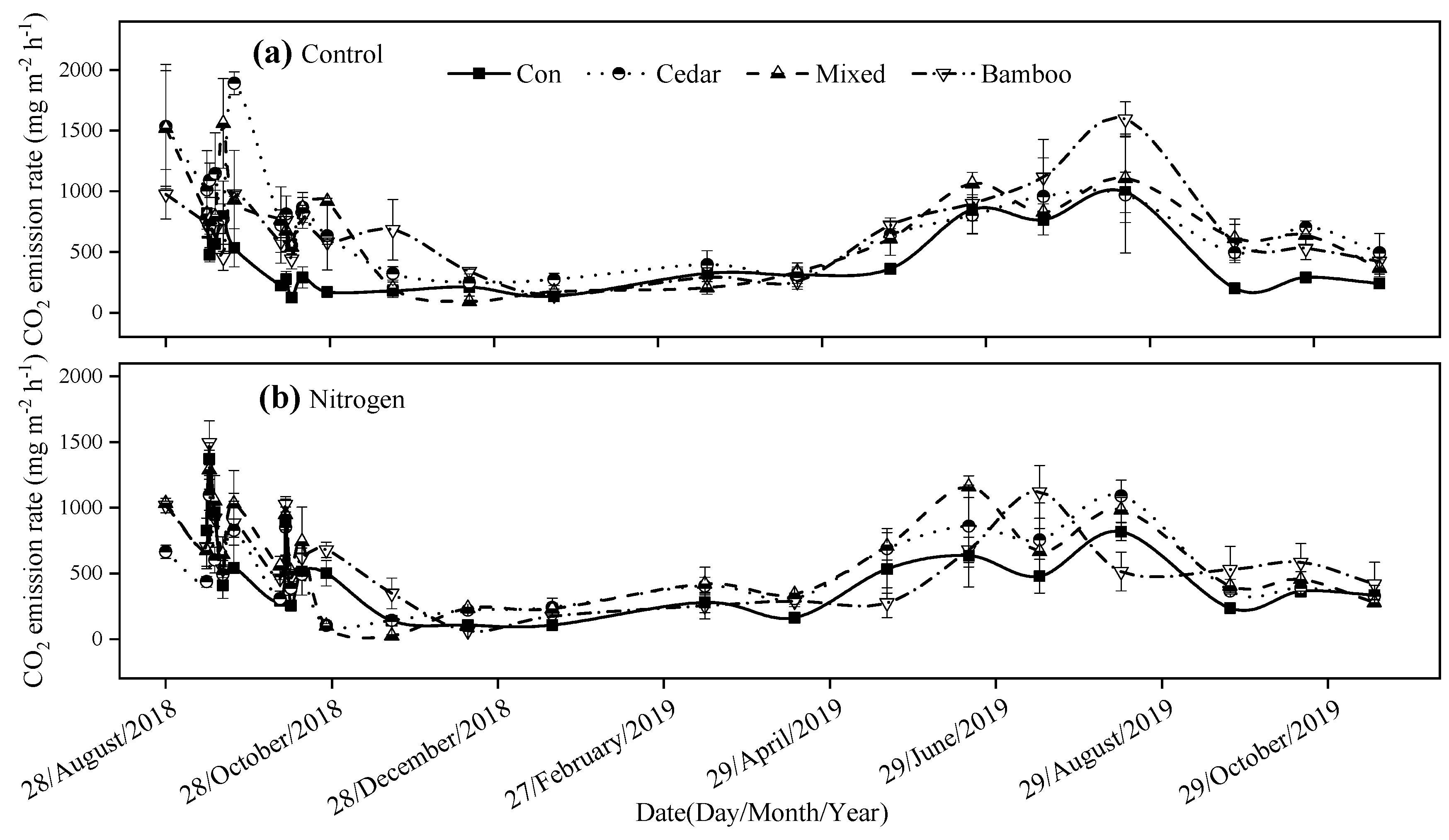
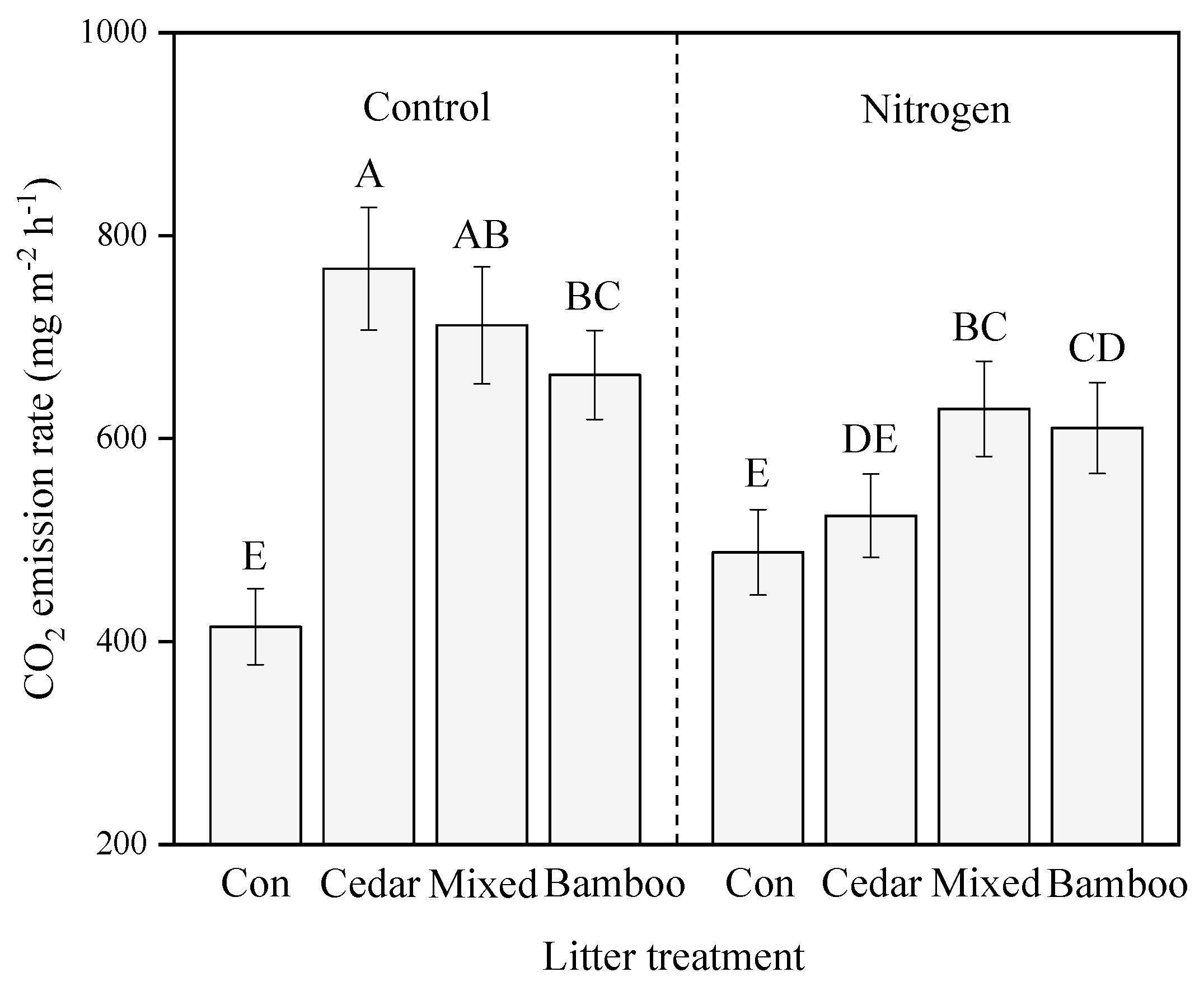
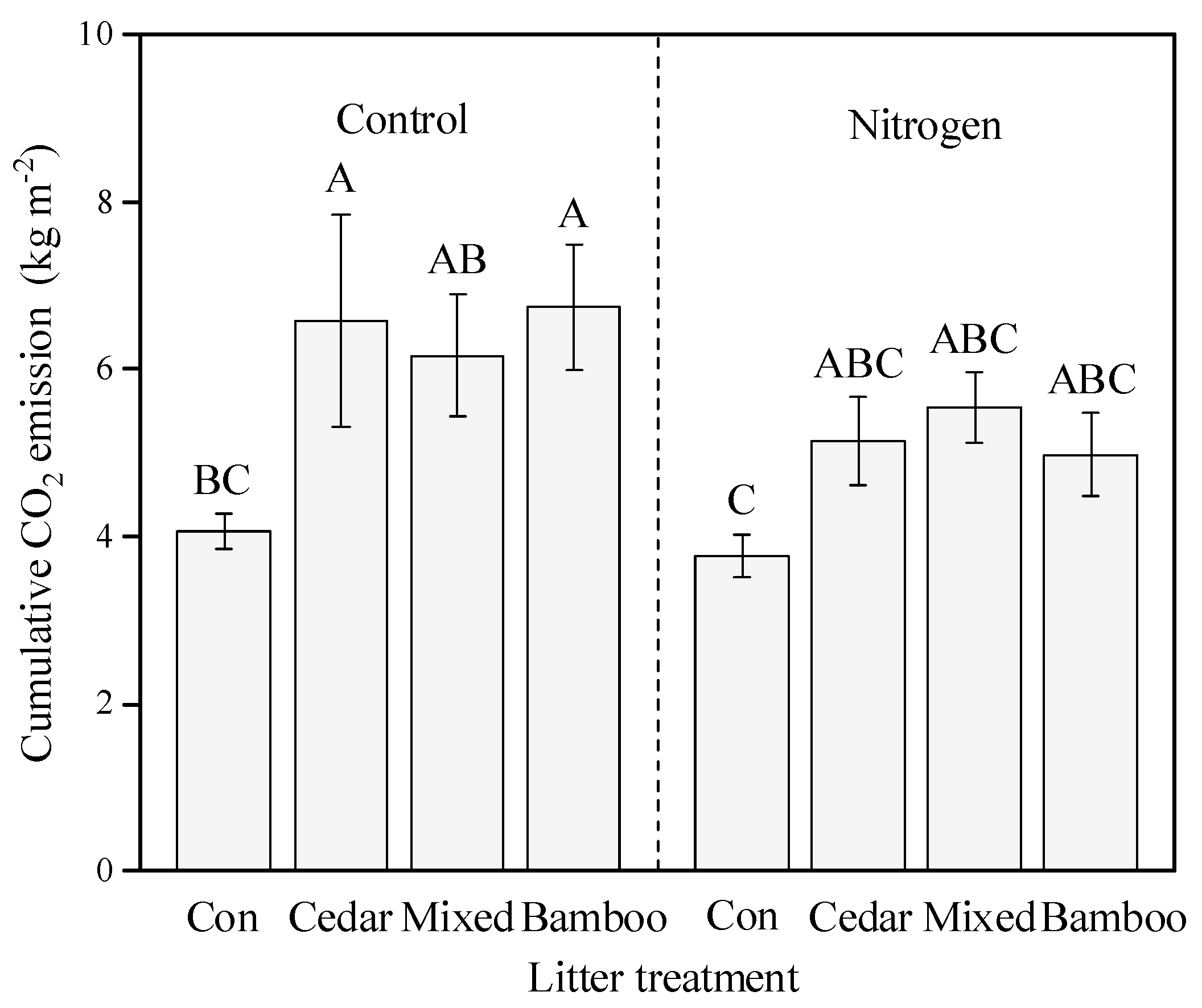
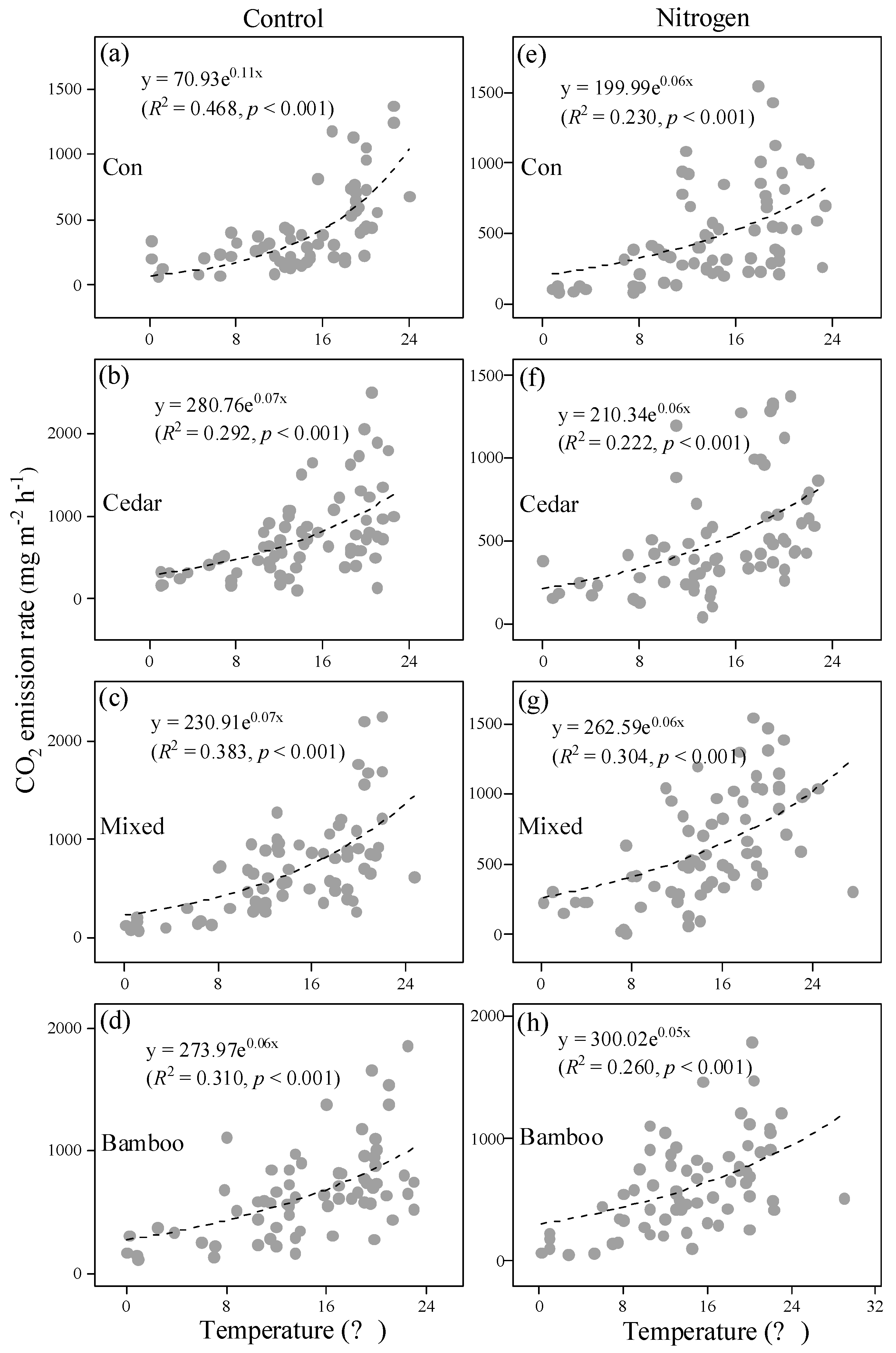
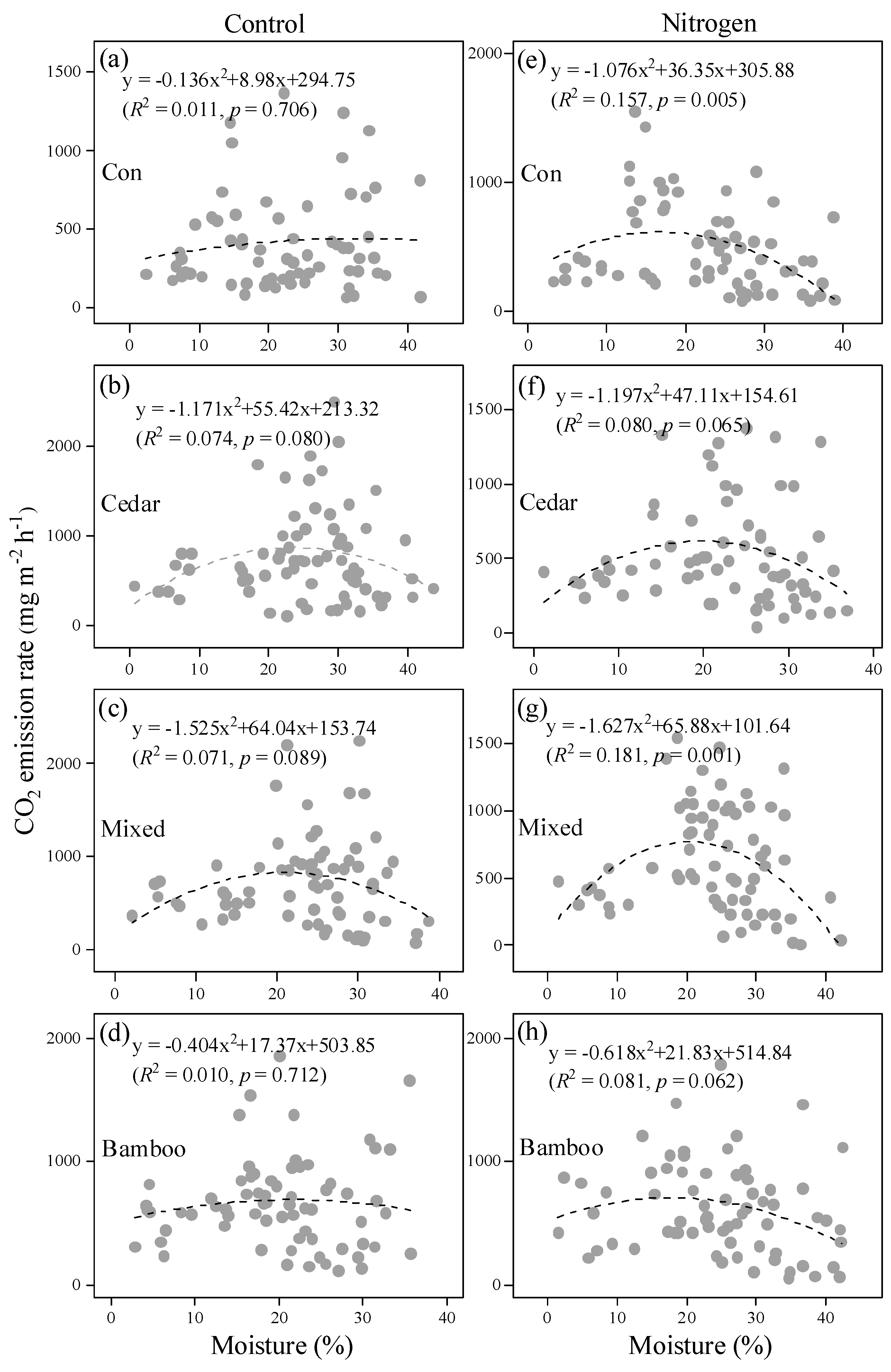
| Litter Treat | C (g kg−1) | N (g kg−1) | C:N |
|---|---|---|---|
| cedar | 461.54 ± 10.37 | 12.47 ± 0.21 | 37.00 ± 0.24 |
| bamboo | 508.67 ± 3.15 | 9.58 ± 0.37 | 53.34 ± 2.05 |
| Treatment | df | Soil Temperature (°C) | Soil Moisture (%) | CO2 Rate (mg m−2 h−1) | |||
|---|---|---|---|---|---|---|---|
| F | p | F | p | F | p | ||
| N treat | 1 | 0.8 | 0.3642 | 6.1 | 0.0137 | 9.7 | 0.0020 |
| Litter treat | 3 | 0.1 | 0.9555 | 6.5 | 0.0003 | 13.2 | <0.0001 |
| N treat × Litter treat | 3 | 2.5 | 0.0580 | 26.8 | <0.0001 | 7.1 | 0.0001 |
| Days & Random | 22 | 279.6 | <0.0001 | 140.9 | <0.0001 | 22.9 | <0.0001 |
| Treatment | df | Soil CO2 Emissions (kg m−2) | ||
|---|---|---|---|---|
| SS (1012) | F | p | ||
| N treat | 1 | 5.87 | 4.6939 | 0.0457 |
| Litter type | 3 | 15.3 | 4.0703 | 0.0251 |
| Litter type × N treat | 3 | 2.03 | 0.5402 | 0.6616 |
© 2020 by the authors. Licensee MDPI, Basel, Switzerland. This article is an open access article distributed under the terms and conditions of the Creative Commons Attribution (CC BY) license (http://creativecommons.org/licenses/by/4.0/).
Share and Cite
Pan, J.; Liu, Y.; Yuan, X.; Xie, J.; Niu, J.; Fang, H.; Wang, B.; Liu, W.; Deng, W.; Kong, F.; et al. Root Litter Mixing with That of Japanese Cedar Altered CO2 Emissions from Moso Bamboo Forest Soil. Forests 2020, 11, 356. https://doi.org/10.3390/f11030356
Pan J, Liu Y, Yuan X, Xie J, Niu J, Fang H, Wang B, Liu W, Deng W, Kong F, et al. Root Litter Mixing with That of Japanese Cedar Altered CO2 Emissions from Moso Bamboo Forest Soil. Forests. 2020; 11(3):356. https://doi.org/10.3390/f11030356
Chicago/Turabian StylePan, Jun, Yuanqiu Liu, Xinyue Yuan, Junyi Xie, Jiehui Niu, Haifu Fang, Baihui Wang, Wei Liu, Wenping Deng, Fanqian Kong, and et al. 2020. "Root Litter Mixing with That of Japanese Cedar Altered CO2 Emissions from Moso Bamboo Forest Soil" Forests 11, no. 3: 356. https://doi.org/10.3390/f11030356
APA StylePan, J., Liu, Y., Yuan, X., Xie, J., Niu, J., Fang, H., Wang, B., Liu, W., Deng, W., Kong, F., Liu, C., & Zhang, L. (2020). Root Litter Mixing with That of Japanese Cedar Altered CO2 Emissions from Moso Bamboo Forest Soil. Forests, 11(3), 356. https://doi.org/10.3390/f11030356






